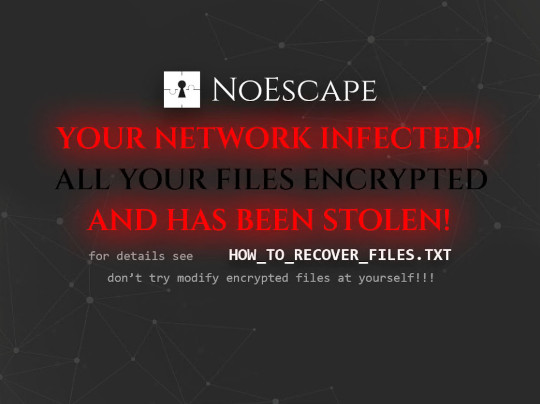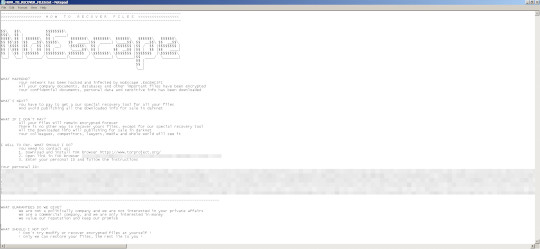Ransom.Win32.NOESCAPE.D
Win32:Evo-gen [Trj] (AVAST)
Windows


Threat Type: Ransomware
Destructiveness: No
Encrypted:
In the wild: Yes
OVERVIEW
Downloaded from the Internet, Dropped by other malware
This Ransomware arrives on a system as a file dropped by other malware or as a file downloaded unknowingly by users when visiting malicious sites.
It drops files as ransom note. It avoids encrypting files with the following file extensions.
TECHNICAL DETAILS
380,416 bytes
DLL
No
19 Jul 2023
Collects system information, Displays graphics/image, Displays message/message boxes, Encrypts files
Arrival Details
This Ransomware arrives on a system as a file dropped by other malware or as a file downloaded unknowingly by users when visiting malicious sites.
Installation
This Ransomware drops the following files:
- %Application Data%\wallpaper.jpg
(Note: %Application Data% is the current user's Application Data folder, which is usually C:\Documents and Settings\{user name}\Application Data on Windows 2000(32-bit), XP, and Server 2003(32-bit), or C:\Users\{user name}\AppData\Roaming on Windows Vista, 7, 8, 8.1, 2008(64-bit), 2012(64-bit) and 10(64-bit).)
It adds the following processes:
- wmic SHADOWCOPY DELETE /nointeractive
- wbadmin DELETE SYSTEMSTATEBACKUP -deleteOldest
- wbadmin DELETE SYSTEMSTATEBACKUP -keepVersions:0
- wbadmin DELETE BACKUP -deleteOldest
- wbadmin DELETE BACKUP -keepVersions:0
- vssadmin Delete Shadows /All /Quiet
- bcdedit /set {default} recoveryenabled No
- bcdedit /set {default} bootstatuspolicy ignoreallfailures
It adds the following mutexes to ensure that only one of its copies runs at any one time:
- Global\{Hash of Machine GUID}
Other System Modifications
This Ransomware modifies the following registry entries:
HKEY_LOCAL_MACHINE\SOFTWARE\Microsoft\
Windows\CurrentVersion\Policies\
System
EnableLUA = 0
(Note: The default value data of the said registry entry is 1.)
HKEY_LOCAL_MACHINE\SOFTWARE\Microsoft\
Windows\CurrentVersion\Policies\
System
ConsentPromptBehaviorAdmin = 0
(Note: The default value data of the said registry entry is 5.)
It sets the system's desktop wallpaper to the following image:
- %Application Data%\wallpaper.jpg

Process Termination
This Ransomware terminates the following services if found on the affected system:
- Culserver
- DefWatch
- GxBlr
- GxCIMgr
- GxCVD
- GxFWD
- GxVss
- QBCFMonitorService
- QBIDPService
- RTVscan
- SavRoam
- VMAuthdService
- VMUSBArbService
- VMnetDHCP
- VMwareHostd
- backup
- ccEvtMgr
- ccSetMgr
- dbeng8
- dbsrv12
- memtas
- mepocs
- msexchange
- msmdsrv
- sophos
- sql
- sqladhlp
- sqlagent
- sqlbrowser
- sqlservr
- sqlwriter
- svc$
- tomcat6
- veeam
- vmware-
- converter
- vmware-usbarbitator64
- vss
It terminates the following processes if found running in the affected system's memory:
- 360doctor
- 360se
- Culture
- Defwatch
- GDscan
- MsDtSrvr
- QBCFMonitorService
- QBDBMgr
- QBIDPService
- QBW32
- RAgui
- RTVscan
- agntsvc
- agntsvcencsvc
- agntsvcisqlplussvc
- anvir
- anvir64
- apache
- axlbridge
- backup
- ccleaner
- ccleaner64
- dbeng50
- dbsnmp
- encsvc
- excel
- far
- fdhost
- fdlauncher
- httpd
- infopath
- isqlplussvc
- java
- kingdee
- msaccess
- msftesql
- mspub
- mydesktopqos
- mydesktopservice
- mysqld-nt
- mysqld-opt
- mysqld
- ncsvc
- ocautoupds
- ocomm
- ocssd
- onedrive
- onenote
- oracle
- outlook
- powerpnt
- procexp
- qbupdate
- sqbcoreservice
- sql
- sqlagent
- sqlbrowser
- sqlmangr
- sqlserver
- sqlservr
- sqlwriter
- steam
- supervise
- synctime
- taskkill
- tasklist
- tbirdconfig
- thebat
- thunderbird
- tomcat
- tomcat6
- u8
- ufida
- visio
- wdsw
- fsafe
- winword
- wordpad
- wuau
- clt
- wxServer
- wxServerView
- xfssvccon
Information Theft
This Ransomware gathers the following data:
- Host Name
- IP Address
Other Details
This Ransomware does the following:
- Empties Recycle Bin
- It encrypts files from local drives, removable drives, and network shares.
Ransomware Routine
This Ransomware avoids encrypting files found in the following folders:
- $recycle.bin
- $windows.~bt
- $windows.~ws
- %PROGRAMFILES(x86)%
- %PUBLIC%
- %ProgramData%
- %SYSTEMDRIVE%\Program Files
- %SYSTEMDRIVE%\Users\All Users
- %SYSTEMDRIVE%\Windows
- %TMP%
- %USERPROFILE%\AppData
- AppData
- %AppData%
- EFI
- Intel
- MSOCache
- Mozilla
- Program Files
- ProgramData
- Tor Browser
- Windows
- WINDOWS
- boot
- perflogs
- system volume information
- windows.old
(Note: %ProgramData% is a version of the Program Files folder where any user on a multi-user computer can make changes to programs. This contains application data for all users. This is usually C:\ProgramData on Windows Vista, 7, 8, 8.1, 2008(64-bit), 2012(64-bit) and 10(64-bit), or C:\Documents and Settings\All Users on Windows Server 2003(32-bit), 2000(32-bit) and XP.)
It drops the following file(s) as ransom note:
- {Ecrypted Directory}\HOW_TO_RECOVER_FILES.txt
- %Desktop%\HOW_TO_RECOVER_FILES.txt

It avoids encrypting files with the following file extensions:
- exe
- bat
- bin
- cmd
- com
- cpl
- dat
- dll
- drv
- hta
- ini
- lnk
- lock
- log
- mod
- msc
- msi
- msp
- pif
- prf
- rdp
- scr
- shs
- swp
- sys
- theme
SOLUTION
9.800
18.656.02
25 Aug 2023
18.657.00
26 Aug 2023
Step 1
Trend Micro Predictive Machine Learning detects and blocks malware at the first sign of its existence, before it executes on your system. When enabled, your Trend Micro product detects this malware under the following machine learning name:
- TROJ.Win32.TRX.XXPE50FFF071
Step 2
Before doing any scans, Windows 7, Windows 8, Windows 8.1, and Windows 10 users must disable System Restore to allow full scanning of their computers.
Step 3
Note that not all files, folders, and registry keys and entries are installed on your computer during this malware's/spyware's/grayware's execution. This may be due to incomplete installation or other operating system conditions. If you do not find the same files/folders/registry information, please proceed to the next step.
Step 4
Restore this modified registry value
Important: Editing the Windows Registry incorrectly can lead to irreversible system malfunction. Please do this only if you know how to or you can seek your system administrator’s help. You may also check out this Microsoft article first before modifying your computer's registry.
- In HKEY_LOCAL_MACHINE\SOFTWARE\Microsoft\Windows\CurrentVersion\Policies\System
- EnableLUA = 0
- EnableLUA = 0
- In HKEY_LOCAL_MACHINE\SOFTWARE\Microsoft\Windows\CurrentVersion\Policies\System
- ConsentPromptBehaviorAdmin = 0
- ConsentPromptBehaviorAdmin = 0
Step 5
Search and delete this file
- %Application Data%\wallpaper.jpg
Step 6
Scan your computer with your Trend Micro product to delete files detected as Ransom.Win32.NOESCAPE.D. If the detected files have already been cleaned, deleted, or quarantined by your Trend Micro product, no further step is required. You may opt to simply delete the quarantined files. Please check the following Trend Micro Support pages for more information:
Step 7
Restore encrypted files from backup.
Did this description help? Tell us how we did.

